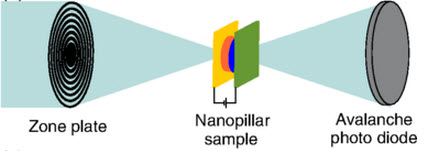Magnetic solitons may lead to more energy-efficient computing
September 10, 2015

Schematic of the x-ray microscopy measurements. The x-ray spot size at the sample was 35 nm and the transmitted x-rays (from the zone plate) were detected by an avalanche photo diode. Images were recorded by raster scanning of the sample. (credit: R. Kukreja et al./Physics Review Letters)
A team of physicists has taken pictures of a theorized but previously undetected “magnetic soliton” that they believe could be an energy-efficient means to transfer data in future electronic devices.
The research, which appears in the journal Physical Review Letters, was conducted by scientists at New York University, Stanford University, and the SLAC National Accelerator Laboratory.
Harnessing solitons to transmit data

Illustration of a water soliton wave. The blue line represents carrier (energy source) waves, while the red line is the envelope. (credit: Wikimedia Commons)
Solitons (solitary waves) were theorized in the 1970s to occur in magnets. They form because of a delicate balance of magnetic forces — much like water waves can form a tsunami. These magnetic waves could potentially be harnessed to transmit data in magnetic circuits in a way that is far more energy-efficient than current methods that involve moving electrical charges, the researchers suggest.
That’s because solitons are stable objects that overcome resistance, or friction, as they move. By contrast, electrons, used to move data today, generate heat as they travel, due to resistance and thus require additional energy, such as from a battery, as they transport data to its destination.
The scientists made the discovery using x-ray microscopy at the Stanford Synchrotron Radiation Lightsource. They observed an abrupt onset of magnetic waves with a well-defined spatial profile that matched the predicted form of a solitary magnetic wave, or magnetic soliton.
“This is an exciting discovery because it shows that small magnetic waves — also known as spin-waves — can add up to a large … wave that can maintain its shape as it moves,” explains Andrew Kent, a professor of physics at NYU and the study’s senior author.
“Magnetism has been used for navigation for thousands of years and more recently to build generators, motors, and data storage devices,” adds co-author Hendrik Ohldag, a scientist at the Stanford Synchrotron Radiation Laboratory (SSRL), where the soliton was discovered. “However, magnetic elements were mostly viewed as static and uniform. To push the limits of energy efficiency in the future we need to understand better how magnetic devices behave on fast timescales at the nanoscale, which is why we are using this dedicated ultrafast x-ray microscope.”
Abstract of X-ray Detection of Transient Magnetic Moments Induced by a Spin Current in Cu
We have used a MHz lock-in x-ray spectromicroscopy technique to directly detect changes in magnetic moment of Cu due to spin injection from an adjacent Co layer. The elemental and chemical specificity of x rays allows us to distinguish two spin current induced effects. We detect the creation of transient magnetic moments of 3 × 10−5μB on Cu atoms within the bulk of the 28 nm thick Cu film due to spin accumulation. The moment value is compared to predictions by Mott’s two current model. We also observe that the hybridization induced existing magnetic moments at the Cu interface atoms are transiently increased by about 10% or 4 × 10−3μB per atom. This reveals the dominance of spin-torque alignment over Joule heat induced disorder of the interfacial Cu moments during current flow.